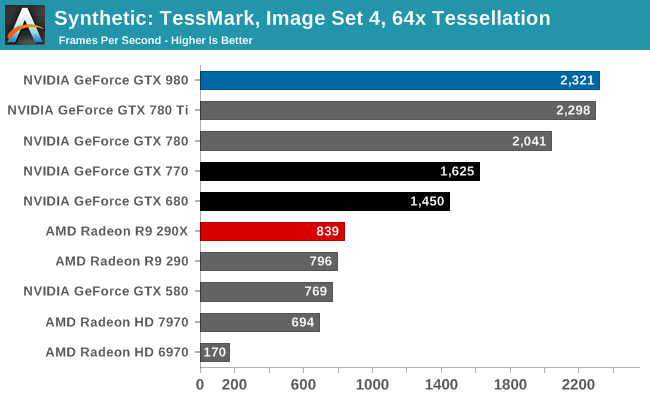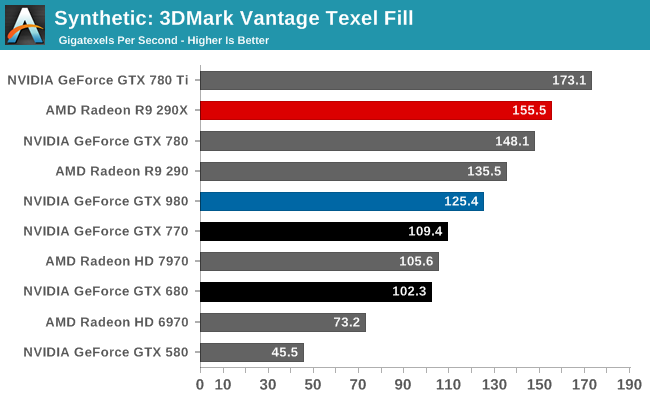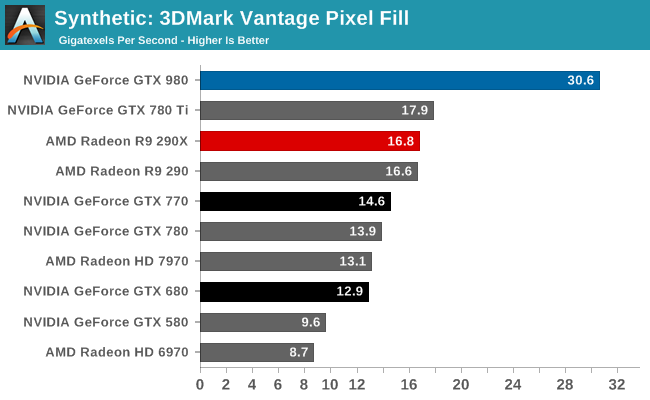The NVIDIA GeForce GTX 980 Review: Maxwell Mark 2
by Ryan Smith on September 18, 2014 10:30 PM ESTSynthetics
As always we’ll also take a quick look at synthetic performance. These tests mainly serve as a canary for finding important architectural changes, and with the exception of pixel throughput we are not expecting any major changes for GTX 980 and GM204.

GM204 is designed to have an ever-so-slightly higher triangle throughput rate than GK110 – 16 tris/clock versus 15 tris/clock, and sure enough the GTX 980 comes out on top in TessMark, slightly edging out the GTX 780 Ti. The difference is only very slight here, and though GM204 should be a bit more powerful than GK110 in practice it’s a dead heat.
Moving on, we have our 3DMark Vantage texture and pixel fillrate tests, which present our cards with massive amounts of texturing and color blending work. These aren’t results we suggest comparing across different vendors, but they’re good for tracking improvements and changes within a single product family.

Beginning with Maxwell NVIDIA reduced their texture-to-compute ratio from 12:1 to 16:1. As a result of this change Maxwell GPUs have fewer texture units than comparable Kepler GPUs. Compounding this effect is the fact that Maxwell CUDA cores are more efficient than Kepler CUDA cores, leading to NVIDIA placing fewer cores overall and further reducing the texture fill rate.
As a result the GTX 980 is not texture fillrate competitive with any of the GK110 cards. It is competitive with the GK104 cards, but only because these cards had the same number of texture units at 128. NVIDIA has told us that they believe this new ratio is a better fit for modern workloads, and judging from the performance we’re seeing elsewhere it would appear that NVIDIA is right.

On the other hand, thanks to NVIDIA’s newer 3rd generation delta color compression technology, our 3DMark pixel fillrate performance is through the roof. GTX 980 comes very close to doubling the throughput of our GK110 cards and more than doubles the throughput of the GK104 cards, reflecting the fact that it has 64 ROPs and more importantly has the available bandwidth to put them to good use.
This benchmark in a nutshell is why NVIDIA can deliver chart-topping performance despite having only 2/3rds the memory bandwidth of GTX 780 Ti. By improving their color compression to this point, NVIDIA can significantly reduce their memory bandwidth requirements Maxwell 2, allowing them to do more with less. In real games the result won’t be anywhere near this remarkable since this is a pure pixel fillrate test, but it goes to show that NVIDIA has been able to expand their effective memory bandwidth in concert with their ROP and shader performance improvements.










274 Comments
View All Comments
takeship - Friday, September 19, 2014 - link
The situation we have here now is very reminiscent of AMD's CPU position shortly after Core 2 hit the market. Nvidia now has a product with better performance, better efficiency, better (still) drivers & features, and similar pricing and that puts AMD in a bad way. The 3xx series had better seriously wow, or AMD's GPU division is quickly going to see the same market erosion that happened after Core 2/iCore. Personally, i think this is a knockout blow. - soon to be former 7970 ownerchizow - Thursday, September 18, 2014 - link
Maxwell is truly amazing stuff. Great advances from Nvidia in virtually every aspect.Not super thrilled about the 980 price at $550, the 970 price however is amazing at $329. I was going to go with the 980 but 2x970s seem more appealing. 970 is 13/16 SMXes but it retains the full 4GB, full 256-bit bus, full 64 ROPs. Hopefully there's a lot of 970s on the full 980 PCBs.
Jensen just confirmed the prices on the Live Stream.
shing3232 - Thursday, September 18, 2014 - link
they have efficiency advantage because because they use the best 28nm call hpm. they use high performance mobile process of course they are very efficientnkm90 - Friday, September 19, 2014 - link
From TSMCs website ( http://www.tsmc.com/english/dedicatedFoundry/techn... )"The 28nm High Performance Mobile Computing (HPM) provides high performance for mobile applications to address the need for applications requiring high speed. Such technology can provide the highest speed among 28nm technologies. With such higher performance coverage, 28HPM is ideal for many applications from networking, and high-end smartphone/ mobile consumer products."It looks like the hpm process was designed for chips that would dissipate much less than the 150-200W this one does. I seriously doubt someone would use hpm for such high power chips. Also some body had the voltages for the gm204 chip; and the idle voltage was closer to the 0.85V of hp than the 0.9V of HPM
chizow - Friday, September 19, 2014 - link
There's no indication they are using 28nm HPM, even the first Maxwell part (GM107) used 28nm HP and alluded to this amazing power/perf ratio we see today with GM104.It is obvious Nvidia's convergence of mobile *design* (not process) fundamentals helped them as we saw with Kepler, and this will only be further beneficial with their mobile Maxwell designs.
Sttm - Thursday, September 18, 2014 - link
Yeah I was looking at 970 results on other sites... its the 8800gt reborn! Almost top end performance, $220 in savings.chizow - Friday, September 19, 2014 - link
Yep the 970 is amazing price:perf, Newegg has them at the $330 price up to $350 for some custom/OC versions.I did end up going with a single 980 though. The difference in build quality is just too much and SLI with my new G-Sync monitor (Swift) have had issues with my current 670 SLI build. The scaling with SLI is also not exceptional with these Maxwell cards (~60%), so the improvement of 2x970 is actually not that much over a single highly overclocked 980.
Still amazing job by Nvidia, the 980 would have been a grand slam at $500 but it is still an Earl Weaver 3-run blast at $550.
uzun - Thursday, September 18, 2014 - link
When will these cards be available via newegg etc?arbit3r - Friday, September 19, 2014 - link
i would guess later tonight maybe tomorrow though that might be wrong.chizow - Friday, September 19, 2014 - link
They are available on Newegg.com now. Some SKUs are selling out now. I picked up two of the EVGA 980 SuperClocked models.